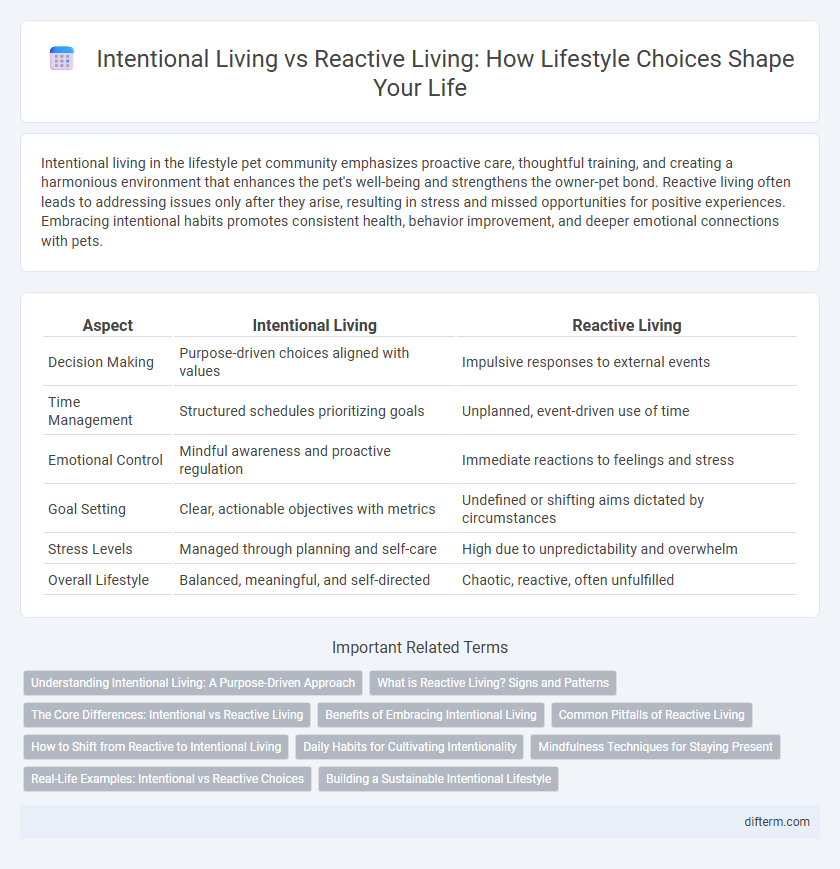Intentional living in the lifestyle pet community emphasizes proactive care, thoughtful training, and creating a harmonious environment that enhances the pet's well-being and strengthens the owner-pet bond. Reactive living often leads to addressing issues only after they arise, resulting in stress and missed opportunities for positive experiences. Embracing intentional habits promotes consistent health, behavior improvement, and deeper emotional connections with pets.
Table of Comparison
| Aspect | Intentional Living | Reactive Living |
|---|---|---|
| Decision Making | Purpose-driven choices aligned with values | Impulsive responses to external events |
| Time Management | Structured schedules prioritizing goals | Unplanned, event-driven use of time |
| Emotional Control | Mindful awareness and proactive regulation | Immediate reactions to feelings and stress |
| Goal Setting | Clear, actionable objectives with metrics | Undefined or shifting aims dictated by circumstances |
| Stress Levels | Managed through planning and self-care | High due to unpredictability and overwhelm |
| Overall Lifestyle | Balanced, meaningful, and self-directed | Chaotic, reactive, often unfulfilled |
Understanding Intentional Living: A Purpose-Driven Approach
Intentional living centers on making conscious choices aligned with personal values and long-term goals, fostering a purpose-driven lifestyle. This approach emphasizes mindfulness and proactive decision-making, contrasting with reactive living, which responds impulsively to external circumstances. Embracing intentional living enhances clarity, fulfillment, and resilience by prioritizing meaningful actions over habitual reactions.
What is Reactive Living? Signs and Patterns
Reactive living is characterized by responding to daily events and external circumstances without proactive planning or intention, often leading to stress and a sense of being overwhelmed. Common signs include frequent distractions, procrastination, emotional decision-making, and a lack of long-term goals or priorities. Patterns such as constant busyness, difficulty setting boundaries, and feeling out of control illustrate how reactive living impacts mental clarity and personal growth.
The Core Differences: Intentional vs Reactive Living
Intentional living revolves around consciously setting goals, making deliberate choices, and aligning actions with personal values, resulting in proactive control over one's life. Reactive living, by contrast, is characterized by responding to external events and circumstances without prior planning, often leading to stress and a lack of direction. The core difference lies in mindset and behavior: intentional living emphasizes foresight and purpose-driven decisions, while reactive living is marked by passivity and immediate reaction to stimuli.
Benefits of Embracing Intentional Living
Embracing intentional living enhances mental clarity, reduces stress, and promotes a sense of fulfillment by aligning daily actions with core values and long-term goals. This conscious approach fosters improved decision-making, better time management, and deeper relationships, as individuals prioritize meaningful experiences over distractions. Research indicates that intentional living contributes to greater overall well-being and resilience against life's unpredictabilities.
Common Pitfalls of Reactive Living
Reactive living often traps individuals in a cycle of stress and missed opportunities due to constant responses to external demands without proactive planning. Common pitfalls include chronic procrastination, lack of clear goals, and diminished mental clarity, leading to decreased productivity and fulfillment. Prioritizing intentional living can mitigate these issues by fostering mindful decision-making and purposeful daily actions.
How to Shift from Reactive to Intentional Living
Cultivating mindfulness through daily reflection enables a shift from reactive to intentional living by fostering awareness of choices and actions. Prioritizing goal-setting aligned with personal values empowers deliberate decision-making, reducing automatic responses to external stimuli. Establishing routines that support well-being, such as meditation or planning, reinforces purposeful habits and enhances overall life satisfaction.
Daily Habits for Cultivating Intentionality
Prioritizing intentional living involves consistently practicing daily habits such as mindful journaling, setting clear goals, and scheduling dedicated reflection periods. These rituals enhance self-awareness, promote deliberate decision-making, and reduce impulsivity inherent in reactive living. Building routines around purposeful actions empowers individuals to align their lifestyle with core values and long-term aspirations.
Mindfulness Techniques for Staying Present
Mindfulness techniques such as focused breathing, body scans, and sensory observation anchor intentional living by cultivating present-moment awareness and reducing reactive patterns. Regular mindfulness practice rewires neural pathways to enhance emotional regulation, decision-making, and resilience against stress-induced reactions. Integrating these techniques into daily routines promotes deliberate actions aligned with core values, fostering a proactive and balanced lifestyle.
Real-Life Examples: Intentional vs Reactive Choices
Choosing to meal prep every Sunday exemplifies intentional living by promoting health and saving time, while grabbing fast food during lunch breaks illustrates reactive living driven by convenience. Another example is setting a consistent bedtime to improve sleep quality versus scrolling through social media late into the night out of habit. Prioritizing monthly budgeting over impulsive spending further highlights intentional financial management compared to reactive debt accumulation.
Building a Sustainable Intentional Lifestyle
Building a sustainable intentional lifestyle requires deliberate choices that prioritize long-term well-being over short-term convenience. Emphasizing mindful habits, such as consistent goal-setting, conscious consumption, and reflective practices, fosters resilience and balance. Intentional living reduces stress and enhances clarity by aligning daily actions with core values and meaningful objectives.
intentional living vs reactive living Infographic

 difterm.com
difterm.com